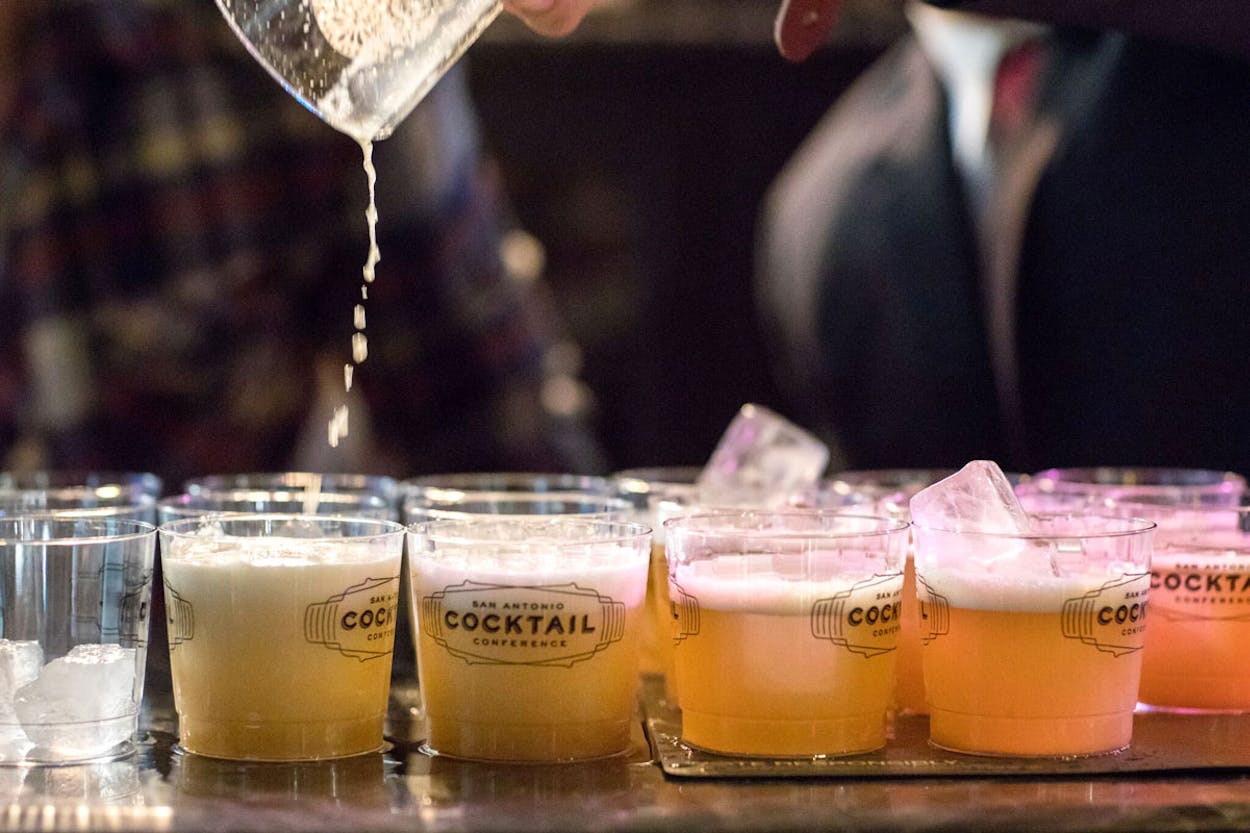Since debuting in 2012, the San Antonio Cocktail Conference has morphed from a fledgling seminar showcasing the city’s then-nascent drink culture into one of the largest cocktail events in the country. This year, from January 10-14, the conference will present more than 70 dinners, seminars, and parties, with attendance “open and accessible to industry and consumers alike,” per the festival’s organizers. To prepare for the 2018 edition, a group of festival presenters and organizers offered Texas Monthly tips on planning, attending, and pacing for this indulgent celebration of spirited creativity.
Make a weekend out of it: SACC Executive Director Cathy Siegel offers a 36-hour plan for newcomers: “I’d stay downtown Friday night, and attend Waldorf On The Prairie at the St. Anthony. On Saturday, I’d stop in to our Bloody Mary bar, or visit our Carajillo [Spanish coffee with brandy, whiskey, or rum] pop-up. Then I’d take some “novice” or “aficionado” seminars, and stop in to the afternoon spirit tasting suites. At that point, you’ll need a nap.” The fest offers a la carte event pricing as well as $350-$500 multi-party passes.
Pace yourself: The festival’s sheer quantity of spirit samples and cocktails is daunting. It is important to drink water at regular intervals, limit yourself to a reasonable number of samples, and—crucially—throw out drinks that you don’t enjoy. “It took me many conferences to learn this, but don’t finish everything, and eat first! Be in it for the long haul,” says Imbibe magazine’s Emma Janzen, author of 2017’s Mezcal: The History, Craft & Cocktails of the World’s Ultimate Artisanal Spirit.
Plan it out: As with all goal-setting, a written plan helps. The tasting suites and sip-and-stroll events have hundreds of drink options. Writer and sommelier Rachel DelRocco says: “Prepare as much as possible, and you’ll get more out of it. Find out who is pouring in advance. You’ll be happy you did.” Setting goals here is easy: “trying five new gins for my home bar” or “five rum cocktail samples to find a recipe for my tiki party” can help give events a personal focus.
Everything old is new again: Over the past decade, the cocktail resurgence has brought back gin, whiskey, tequila, and rum classics to bars and restaurant lists worldwide. With the basics covered, bartenders and producers are now increasingly turning to drinks like sherry and brandy for cocktail bases and accents. Classes on these distinctive spirits can open up new ideas for your home bar—or simply improve your cocktail orders.
Enjoy the city itself: DelRocco points out that the conference’s backdrop is part of the point: “If you’re from out of town, planning a meal or two away from the conference is a must.” Presenter and author Fred Minnick says: “You can get caught up in the moment of San Antonio, and completely forget you’re at a conference.” From the lively Southtown and Dignowity Hill areas to the well-regarded Pearl, there are no shortage of exciting options. (See our January 2018 story about San Antonio’s historic hotels for more ideas,)
Mezcal is in, so dig deeper: Texans are well versed in the smoky, spicy virtues of mezcal. With the spirit’s popularity at an all-time high, this year’s SACC offers deep dives into the regionality of Oaxaca and Mexico’s newly passed “NOM 70” mezcal production laws. For those keen on learning a broad array of Mexican spirits, a expert panel will also discuss “Mexican Denominations Of Origin: A Journey Through Spirits and Flavors” at a tasting January 12.
Explore the unfamiliar: Some wildcards cater to the adventurous: Traffic and Ocean’s Eleven director Steven Soderbergh will screen a film on Bolivian spirit Singani, followed by cocktails from Manhattan’s famed bar Death and Co. (Soderbergh launched spirit brand Singani 63 in 2016.) There’s also a talk on the suddenly hip category of mead, made visible in Texas by the recent success of Central Texas meadery Meridian Hive. Author Minnick says: “Mead, or honey wine, is very historical. This drink is all over the place—from the production methods to the regionality of bees—and it has great flexibility in cocktails.”
Get in the game: With eight seminars on mixology, there’s no excuse not to improve your home bartending. To help guests choose appropriate classes, the conference labels each seminar as novice, aficionado, or industry. Cocktail consultant Jonathan Pogash’s “Mixology 101” is a perennial favorite: “I’ve done this class for five years,” says Pogash. “It’s great for the novice. We do cocktail history, discuss the classics, and teach you to properly use bar tools and fresh ingredients in an interactive format.” Additional focused classes on gin and whiskey cocktails assist enthusiasts with a favorite spirit.
A final note: With so much spirited celebration happening, it is easy to overlook the conference’s philanthropic roots. Since the conference’s inception, the event has donated all fest profits—almost $500,000—to Texas children’s charities.






